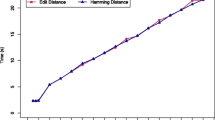Abstract
An algorithm for the computation of the edit distance of run-length coded strings is given. In run-length coding, not all individual symbols in a string are explicitly listed. Instead, one run of identical consecutive symbols is coded by giving one representative symbol together with its multiplicity. The algorithm determines the minimum cost sequence of edit operations transforming one string into another. In the worst case, the algorithm has a time complexity ofO(n·m), wheren andm give the lengths of the strings to be compared. In the best case, the time complexity isO(k·l), wherek andl are the numbers of runs of identical symbols in the two strings under comparison.
Zusammenfassung
Wir geben einen Algorithmus zur Bestimmung der Ähnlichkeit lauflängencodierter Zeichenketten an. Bei der Lauflängencodierung werden nicht alle Symbole einer Zeichenkette explizit angegeben. Statt dessen wird eine Sequenz identischer aufeinanderfolgender Zeichen durch einen Repräsentanten zusammen mit der Häufigkeit des Auftretens dargestellt. Der Algorithmus bestimmt die Folge von Editieroperationen minimaler Kosten, die eine Zeichenkette in eine andere überführt. Im schlechtesten Fall hat der Algorithmus eine Zeitkomplexität vonO(n·m), wobein undm die Längen der zu vergleichenden Zeichenketten bezeichnen. Die Zeitkomplexität im besten Fall isO(k·l), wobeik undl die Anzahl der Sequenzen gleicher Symbole in den beiden Zeichenketten darstellen.
Similar content being viewed by others
Explore related subjects
Discover the latest articles and news from researchers in related subjects, suggested using machine learning.References
Srihari, S. N. (ed.): Computer text recognition and error correction. Silver Spring: IEEE Computer Society Press 1985.
Sankoff, D., Kruskal, J. B. (eds.): Time warps, string edits, and macromolecules; the theory and practice of sequence comparsion. Reading: Addison Wesley Publ. Co. 1983.
Bunke, H. (ed.): Advances in structural and syntactic pattern recognition. Singapore: World Scientific Publ. Co. 1993.
Hall, P. A. V., Dovling, G. R.: Approximate string matching. Computing Surveys12, 381–402 (1980).
Levensthtein, V. I.: Binary codes capable of correcting deletions, insertions, and reversals. Cybernetics and Control Theory10, 707–710 (1966).
Wagner, R. A., Fischer, M. J.: The string-to-string correction problem. Journal of the ACM21, 168–173 (1974).
Hunt, J. W., Szymanski, T. G.: A fast algorithm for computing longest common subsequences. CACM20, 350–353 (1977).
Myers, E. W.: AnO(ND) difference algorithm and its variations. Algorithmica1, 251–266 (1986).
Ukkonen, E.: Algorithms for approximate string matching. Inform. Control64, 100–118 (1985).
Masek, W. J., Paterson, M. S.: A faster algorithm for comparing string-edit distances. Journal of Computer and System Sciences20, 18–31 (1980).
Aho, A. V.: Algorithms for finding patterns in strings. In: J. van Leeuwen (ed.): Handbook of theoretical computer science, pp. 255–300. Amsterdam: Elsevier Science Publishers B. V. 1990.
Author information
Authors and Affiliations
Rights and permissions
About this article
Cite this article
Bunke, H., Csirik, J. An algorithm for matching run-length coded strings. Computing 50, 297–314 (1993). https://doi.org/10.1007/BF02243873
Received:
Issue Date:
DOI: https://doi.org/10.1007/BF02243873




